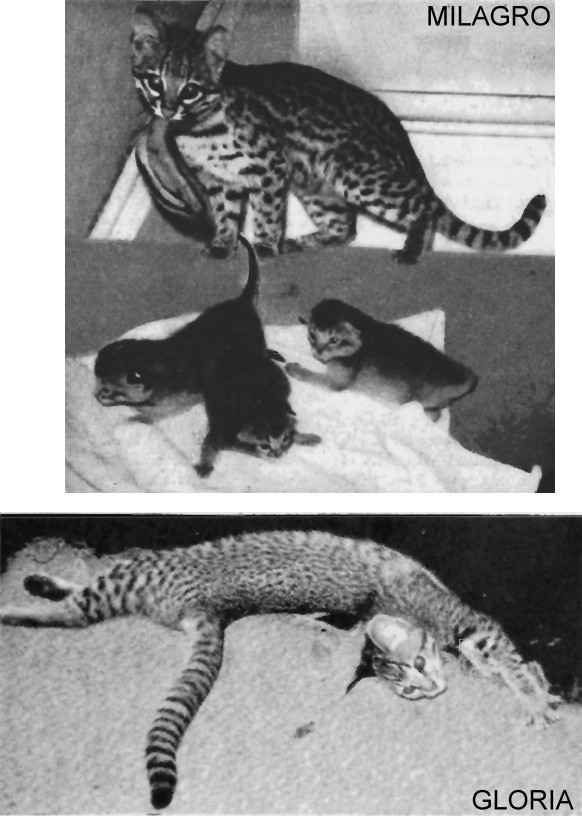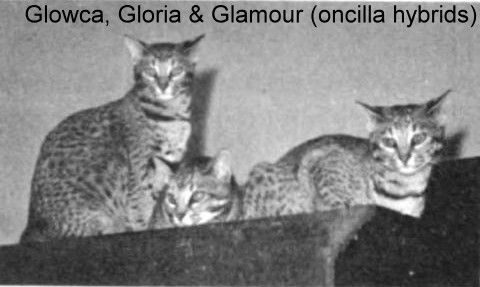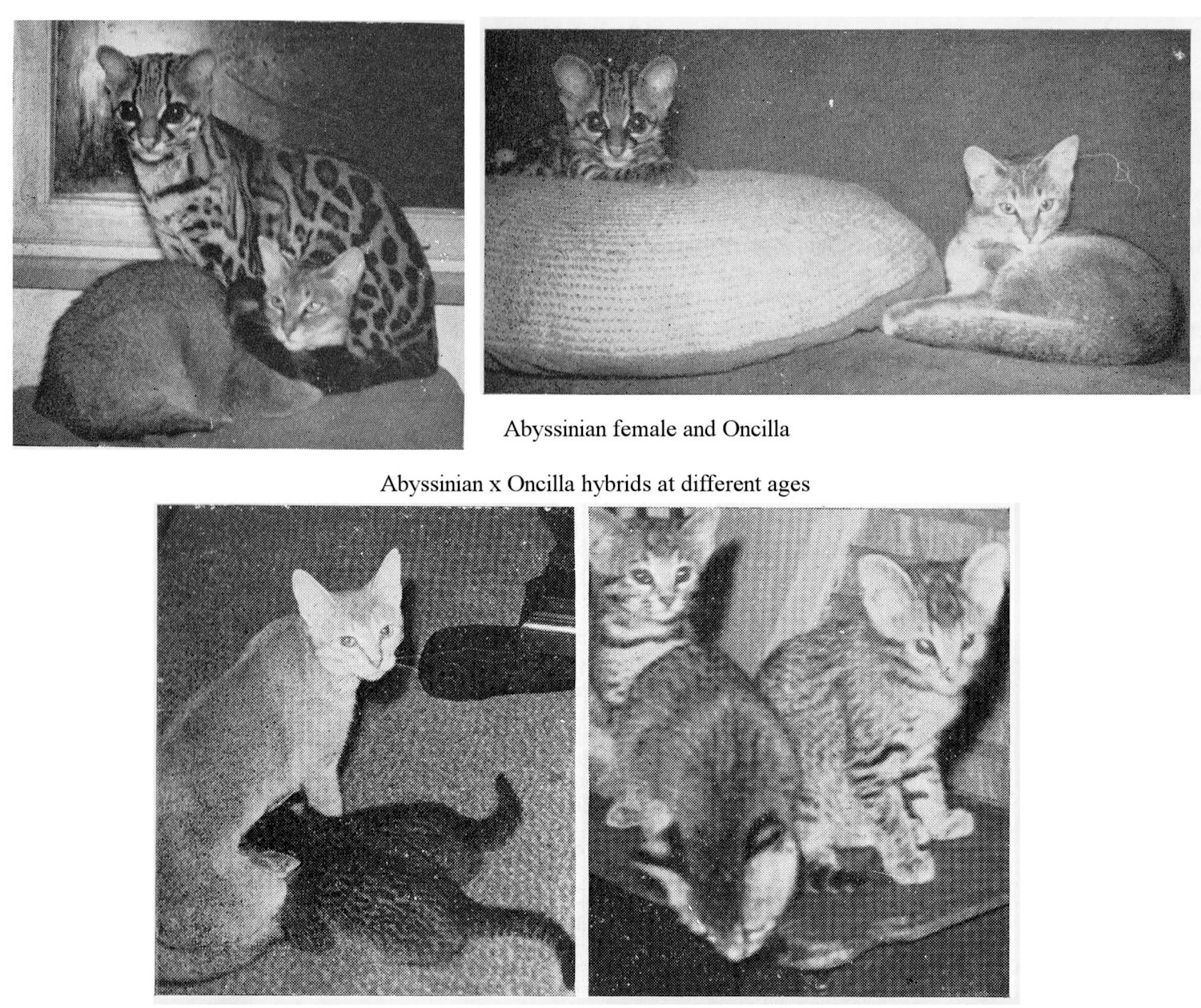
DOMESTIC X ONCILLA AND BLACK FOOTED CAT HYBRIDS
DOMESTIC X ONCILLA HYBRIDS
F. tigrina, the Tiger Cat (Little Spotted Cat/Oncilla) can interbreed although most offspring are stillborn and meetings between Tiger Cats and domestic cats normally resulted in the death of the domestic cat due to the Tiger Cat's highly aggressive nature. Paul Leyhausen reported successful matings between a male Oncilla and a female domestic cat. Out of seven kittens born, three were stillborn. However, the Oncilla male was notably aggressive towards female Oncillas and it also killed a domestic female much larger than itself.
Long Island Ocelot Club newsletters of November/December 1964, May/June 1966 and May/June 1968 carried reports of the Oncilla/domestic hybrids bred in Arnhem, The Netherlands by Maria Falkena-Rohrle. The 6-8 lb Oncilla was also known as the "dwarf ocelot". As well as studying oncilla family behaviour, Mme Falken Rohrle was attempting to cross Oncillas with Margays. She had raised the Oncillas alongside domestic Abyssinians in order to make them better housepets. She was mating a female oncilla called Candy to an oncilla male called Milagro. Falkena-Rohrle wrote that Dr Zimmerman in Mt Vernon had been most helpful when Candy was expecting her first litter and again when Iris, an Abyssinian domestic cat, had her litter of oncilla hybrids.
Iris had been calling, but Falkena-Rohrle did not want her to have another litter and kept her separated from the male Abyssinians, but forgot that oncilla stud Milagro might be interested in the much larger domestic cat. She observed Milagro mating with Iris, but was assured the mating would result in nothing but dead kittens if it resulted in anything at all. One authority said that the Oncilla, belonging to the ocelot group had a different number of chromosomes than the domestics and the pair could not breed. When Iris appeared to be pregnant, the owner expected nothing more than a dead kitten and 61 days after the mating she found a dead kitten in Iris's basket, soon followed by another stillborn kitten. Two hours later a live kitten was born and the birth was also witnessed by Mrs Ewer, a well known zoologist from Ghana who was visiting Falkena-Rohrle to to see the cats.
The kitten developed nicely, "not troubling herself about chromosomes and things", and looked more and more like the oncilla sire as she grew. Falkena-Rohrle named her Gloria and she grew up in the care of two Abyssinian mothers whose four male kits were born a few hours before Gloria. It was extremely interesting compare the development of Gloria with Candy's pure-bred oncilla kittens (Victor and Victoria). The two dead hybrid kittens were shipped at the request of Falkena-Rohrle's veterinarian to a friend who is a professor in a Texas university who wished to study the chromosomes of feline hybrids.

According to some reports, Mme Falken-Rohrle was intrigued as to whether the kitten, named "Gloria" was a hybrid or a mutation of the Abyssinian so she deliberately bred an Abyssinian male to an Oncilla female resulting in three more hybrids. It appears from the LIOC newsletters that by 1966, Milagro (oncilla male) and Iris (Abyssinian) had produced three living hybrids which received wide acclaim in European feline fanciers' circles, and abroad in "CATS", a USA magazine as "Glowca, Gloria and Glamour, famed oncilla-abysinnian hybrid trio". Milagro had had to be defanged after killing an older - and larger - female cat, Snoesje, through a bite to the neck.

The Oncilla has two chromosomes fewer (36) than the domestic cats (38), explaining why the Oncilla-Abyssinian hybrids - all female - had all been sterile and possibly why none of the male hybrids had survived. Although the two species were able to produce hybrids, there appears to have been enough mismatch that both sexes were sterile rather than only the males being sterile. The comparable case of the Safari breed (Geoffroys x domestic), with a similar mismatch, results in sterile males and some fertile females.
The Oncilla-Abyssinian hybrids were described by Leyhausen and Falkena as "very beautiful". Their coats had three longitudinal stripes down the back and the rest was patterned with small spots partly arranged into rosettes. The tails were ringed with a number of black hoops. The tail-tip was black.
The same breedings were mentioned in the newsletter of the Long Island Ocelot Club newsletter of September/October 1981; Leyhausen kept a number of oncillas and bred them, comparing their behaviour to that of other small wildcats as well as to domestic cats. Together with the German cat breeder, Maria Falkena-Rohrle, he successfully hybridized oncillas with domestic cats.
Leyhausen, P and Falkena M (1966) Breeding the Brazilian ocelot-cat (Leopardus tigrinus) in captivity. International Zoo Yearbook Vol 6; 176-182
Following are excerpts from "Abyssinian x Wild Cat by Maria Falkena (Holland)", published in "Our Cats", August 1965. These provide further details about the appearance and behaviour of the hybrids.
"Two young cats, spotted in the way ocelots are; four very small cats, one of them six months old, the other three about ten weeks - these are the kittens I write about today. In November 1963 we were given the opportunity to purchase an oncilla male, probably the only one in captivity. We christened him "Milagro", which is the Spanish term for "wonder," and judged him to be about 8 months old. In the following spring he mated Candy (an oncilla) and the result was an undersized kitten which only lived three days. A second mating produced two little oncilla babies.
The other four [kittens] are hybrids. The father is Milagro, the oncilla male, and the mother Iris, an Abyssinian female. The first mating of this sort took place accidentally and we did not expect anything more than dead kittens as we had been informed that cats of the ocelot group [i.e. ocelot, margay, oncilla] were too far away from our domestic cat for any mating to be successful. News of the birth of the "impossible cat" was broadcast and written up by an illustrated journal. We called this first hybrid kitten Gloria and of course we looked after her most carefully. In appearance and behavour Gloria holds the middle between her wild ancestors and the Abyssinians. her movements are quicker and more spontaneous. She refuses other food than meat, like the oncillas do, but will also eat it boiled, which the oncillas will not. She has a long lean body and her head and the texture of her coat are definitely those of her father. From him she has inherited the warm brown eyes and the round ears with the white spot inside. But the spots are much smaller than Milagro's, all very close and neatly arranged.
A second mating between Milagro and Aurelia, another Aby female, produced three more hybrids, all looking and behaving like Gloria; all females. The mother is just as proud and happy with them as any queen with her kittens. Now and again it appears she does not quite understand the different voice which her babies have. As they develop and Aurelia's interest fades as they reach the age when Aby kittens are self-supporting, the attachments of the little hybrids becomes directed more towards me. When I enter and speak to them, they will wake up and roll up into a ball in the true oncilla fashion. This is a funny sight, especially to strangers.
My hybrids have lost the habit which unfortunately the oncilla has got - they do not spray. They are not so nervous but they have not kept the attractive markings of the wild cat. We might get the spots back by crossing the hybrids back to Milagro - that is, of course, they are fertile hybrids. Ever since I have bred the hybrids, many requests have come in for them, also requests for Milagro to be allowed to mate Siamese and Havanas. I would not entertain any of them. What a mixture I should be responsible for in the Fancy is unlimited crossing with wild cats were encouraged? Perhaps her response would have been different in the 1990s as various wild cat hybrids were being developed and Pandora's box has been well and truly opened. Crossing an oncilla to a spotted tabby would likely have preserved the spots in the hybrids. I suspect the end result would have been similar to the modern Bengal.

In 1966, a report by Professor Leyhausen was published in the International Zoo Yearbook (6: 176-182), naming Madam Falkena-Rohrle as a co-author, although she had contributed only the dates and observations, comparing her Oncilla hybrids’ pattern to that of the Geoffroy’s cat. In the first issue of Grzimek's "Animal Life, Encyclopaedia of the Animal Kingdom" of 1970, her hybrids were reported in the same way and compared to the Geoffroy’s Cat and the Kodkod (Leopardus guigna).
Gloria, the original Oncilla hybrid, was a very sociable cat, always looking for contact with the other cats and with her human family. The three new Oncilla hybrids (all female0 were identical in appearance to Gloria, but very different in character. The three sisters were too busy with each other to interact with Gloria, but Gloria often sought the company of her half-sisters.
Aurelia, one of the Abyssinian mothers, seemed to feel that she was not raising ordinary kittens. She was restless, probably because her babies were unusually alive. She repeatedly moved with her little ones, sometimes to a chair, sometimes under the table, and once even pulling down a Christmas tablecloth (and biscuits on it) for a nest. When the young became independent they had an overpowering urge to make mischief. They were never afraid of the other cats, one of whom sought refuge on top of a cupboard when they approached.
Gladys was the smallest of Aurelia's hybrid babies and had a quite Abyssinian character. Glamour was a stronger character, somewhat reserved, but still friendly. Glauca was practically a real wildcat who hissed when touched, scratched and displayed her wild heritage. None of the three ever became very tame, but Glauca remained the wildest and eventually became difficult for the other cats. Speaking many years later, Mrs Falkena-Rohrle said she would not cross a wild cat, such as Milagro, with a domestic cat. Taming is not hereditary and the combination of genes could create a conflict of hereditary traits which could turn a normal defensive urge degenerates into outright aggression, or could cancel each other out to produce a very gentle animal. Gladys, Glamor and Glauca were certainly conflicted – “two souls in one breast” according to Professor Leyhausen.
DOMESTIC X BLACK-FOOTED CAT HYBRIDS
According to H.C. Brooke in “Cat Gossip,” 8th August 1928, “Old fanciers will remember that some thirty odd years ago some exquisite little spotted African Wild Cats wore exhibited by a then well-known Southern Judge and exhibitor, Mr. Billett. These must have been specimens of that charming little S. African variety, the Black-footed Cat. It was stated at the time that a tame queen in Mr. Billett’s possession was in kitten to one of these cats, but we never heard how matters turned out. It is a thousand pities that animal dealers never take the trouble to import these cats, from which, with luck, we might obtain a really good strain of spotted cats. The Director of the Pretoria Zoological Gardens possessed a half-bred cat a while ago, perfectly tame, which exactly resembled its wild sire; and we feel quite sure that the spotted cat we exhibited at Croydon some five years ago which won first in a good class of “ spotties” under Mr. Sam Woodiwiss, was so bred. “
The Black-footed cat (F. nigripes) will breed with both domestic cats and F. lybica, though the fertility of the hybrid offspring is not recorded. The Black-footed cat (F nigripes) is considered one of the most unsociable cats and contact between the two sexes is reduced to an absolute minimum, occuring only when the two sexes come together for breeding. Paul Leyhausen successfully bred Black-footed cats in captivity and had no difficulty in mating his Black-footed cats with domestic cats. In the wild, they are reliably reported to interbreed with caffer cats (the South African form of the African wildcat). The gestation period of the Black-footed cat averages sixty-three days, close to that of the domestic cat and African/European Wildcats.
Guggisberg, C.A.W. Wild Cats of the World. 1975
You are visitor number